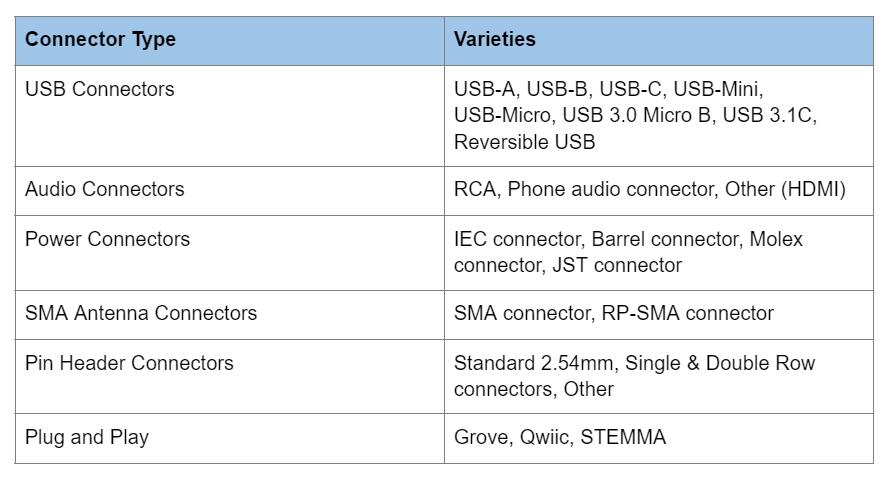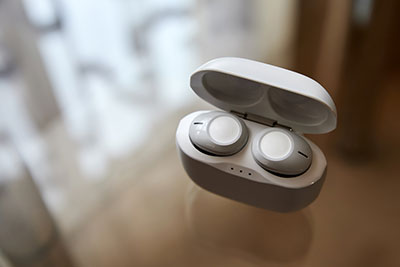While some devices can communicate wirelessly, cabling is essential for reliable, high-speed data transmission and power supply. The most common cables for this application are interfacing cables connectors, and you will find them in almost all electrical items.
These cables create non-permanent links between different boards or devices. Therefore, if you want to put together a modular project, they will come in handy. We have looked at the various interface cables/ connectors types below, so take a look to find the most relevant ones for your project.
Contents
- What are Interfacing Cables?
- Various Connectors and Their Categories
- USB Connectors
- USB Type-A
- USB Type B
- USB Mini
- USB Micro
- USB 3.1 C
- USB 3.0 Type-A
- USB 3.0 Type-B
- USB 3.0 Micro B
- USB 3.0 Internal Connector
- USB 3.1 Internal Connector
- Reversible USB
- Audio Connectors
- Power Connectors
- IEC Connectors
- Barrel Connectors
- Molex Connectors
- JST Connectors
- SMA Antenna Connectors
- Pin Header Connectors
- Plug and Play
- Grove
- Qwiic
- STEMMA
- Summary
What are Interfacing Cables?
Interfacing cables are power and data transfer cables used to link different electrical conductors to form a circuit. Also, it is a cable used to connect devices and peripherals to the central unit.

Various interfacing cables and connectors
Various Connectors and Their Categories

USB Connectors
USB connectors are in a wide range of devices that most people use daily. They are common in peripheral-to-host USB communication, and they usually come preloaded with the device driver for plug-n-play use. Also, they feature power pins to power the external device before creating a data link. However, they come in different types, which include:
USB Type-A
The USB Type-A is the primary connector used in desktop PCs to connect to USB mass storage devices, chargers, and input devices, such as keyboards. It has variations like USB 2.0, which has a bandwidth of 480 Mbps, and USB 3.0 for SuperSpeed transfer mode. USB 3.0 usually has a blue-colored tip and is over 10x faster than USB 2.0 because it has a bandwidth of 5 Gbps. USB 2.0 has a 5-meter maximum cable length, but the 3.0 standard does not specify this parameter.

A USB Type-A connector
USB Type B
Though not as common as USB Type-A, this standard has a robust build quality with a bulky design. It is common in peripheral devices like printers to give maximum reliability. However, these devices usually come with a USB Type-A connector cable for compatibility with most computers.
USB Mini
USB Type-A was perfect for larger devices, but it was too large for compact, portable devices, such as gaming consoles. The mini USB standard was the first attempt at reducing the connector size to fit structurally in these devices.
USB mini B came as an improvement to USB mini, and it included an extra pin to support OTG (USB On-The-Go). This feature allowed the peripheral or mobile, portable device to function as a USB host. A host device is responsible for directing traffic flow to devices.
USB Micro
The mini class of USB devices, especially USB mini B, fitted perfectly in earlier devices but was very thick. Therefore, it was not ideal for modern smartphones with sleek profiles. The USB port needed a change, and USB Micro emerged. USB Micro B came about as an improvement, adding a fifth contact pin to allow low-speed signaling for OTG applications.
USB 3.1 C
The USB Type-C interface cable plug is a relatively new connector, and it features the 3.1 USB standard with 24 contact pins and a reversible design. Even though it is small, USB C is powerful (allows current above 500mA for power-hungry devices) and fast.
Many modern peripherals that supported Type-A are transitioning to Type-C cable ports for faster communication with a host device. Portable devices like smartphones are also switching from USB Micro to Type-C.
The latest Type-C USB standard has the speed advantage because it supports 40 Gbps data transfer speeds. Therefore, it makes sense for manufacturers to make this switch.
A newer USB4 specification using the Type-C connector supports DisplayPort 2.0 over the alternative mode.

Various types of USB connectors
USB 3.0 Type-A
As explained earlier, a USB 3.0 Type-A interface cable enhances the connection speeds provided by USB Type-A and Type-B. Additionally, it allows device-initiated communications to the host device. It is important to note that this 3.0 standard introduced a crossover A-to-A cable without power for linking two PCs.

Various connectors. Note the blue-colored tip of USB 3.0
USB 3.0 Type-B
This 3.0 Type-B enhances the performance of the earlier version (Type-B) for printers and other peripherals. It supports the bandwidth speeds of USB 3.0 and has a different cable plug design that cannot fit in USB 2.0 Type-B sockets.
USB 3.0 Micro B
USB 3.0 Micro B cable plugs resemble USB 2.0 Micro B connectors but feature more pins to increase the data transfer speeds. They are common in devices that require high data transfer speeds like external drives.

A comparison of various USB connectors
USB 3.0 Internal Connector
This 20-pin internal socket connects the external SuperSpeed USB ports on the front panel to the motherboard. The single cable features two internal USB 3.0 signal channel lines that allow two SuperSpeed ports to share the connector.
USB 3.1 Internal Connector
Like the 3.0 internal connector, this cable features a 20-pin plug but has a smaller form factor and a sturdier mechanical latch. The single connector supports two USB Type-A ports or a single Type-C cable connection. But there is a newer 40-pin version that can handle the bandwidth of two Type-C cable ports.
Reversible USB
Apart from USB Type-C, the other USB ports are not reversible. It can be frustrating to find the right side up for connecting the plug to the port, but with reversible USB connectors, you can plug-in in any orientation.
Special Offer: Get $200 off your order!
Email [email protected] to get started!
Audio Connectors
The purpose of audio connectors is to transmit audio from one device to another. In most cases, transmission is from an audio device to headphones, speakers, or other audio transmitters. The most common audio connectors are:
- RCA audio interface: RCA usually contains a white/black header for left audio, a red one for right audio, and a yellow one for video equipment. It is losing relevance in favor of single header connectors like HDMI. HDMI is a common feature in modern AV equipment (TVs and monitors) because it provides a video and an audio device function in a single connector.

RCA connectors
- Phone connectors: Almost every phone has a 3.5mm jack. It comes in three variations: TS transmits mono & unbalanced signals from the audio device, TRS does stereo, and TRSS can handle stereo plus a microphone. Apart from the 3.5mm audio interface, there are 2.5mm and 6.35mm connectors.

A 3.5mm jack and a 6.35mm converter
Power Connectors
As the name suggests, power connectors are interfacing cables used to supply power to devices. There are several varieties, but the most common ones are:
IEC Connectors
Most power connectors in desktop PCs and household appliances have IEC power connectors, usually for AC power input. It has several variations, such as IEC 60320, 62196, 60906-1, etc. IEC 60320 is more common among these variations.
Barrel Connectors
Also known as coaxial power connectors, these power cables are common in affordable electronics and portable devices with AC wall adapters, such as laptop chargers and gaming consoles.
Molex Connectors
Most internal drives, graphics cards, optical drives, and internal peripherals in personal computers feature Molex power connectors. They can transmit up to 11A, enough current to power these devices, 3D printers, etc.

A Molex power cable
JST Connectors
Radio-controlled servos, rechargeable battery packs, battery balancers, etc., use JST connectors. Like Molex connectors, this one has the female power pin at the cable end while the male power pin sits inside a plastic shell.
SMA Antenna Connectors
The SMA antenna connectors come in the following two types:
- SMA (Sub-Miniature version A): Coaxial RF connectors
- RP (Reverse Polarity) SMA connectors: Reverses the interface gender
Earlier versions of WiFi devices used SMA connectors to increase their gain. However, this breached the national regulation, leading to the adoption of RP-SMA as the improved version.

SMA connectors
Pin Header Connectors
Pin headers act as bridges between two PCBs. The most common among them are the 2.54mm single and double row pin headers (breadboard compatible pitch standards). Arduino boards and shields use these connectors. You can also find them in DuPont / Jumper cable to breadboard connections.

Pin header connectors for Arduino
Plug and Play
Plug and play connectors encompass various types, namely grove, Qwiic, and STEMMA.
Grove
A Grove system features a stem as the base unit and multiple modules or twigs with standardized connectors. However, the base unit is not necessary because the system contains a Grove to Pin Header converter. This component helps run Arduino or Raspberry Pi pins on Grove connectors.
Qwiic
As Sparkfun's I2C prototyping system, Qwiic uses a single cable with an ST SH 4-pin connector. Additionally, Qwiic has adapters for linking Arduino pin headers to Qwiic devices.
STEMMA
STEMMA is Adafruit's plug-and-play version, and it features three connector types. These are STEMMA QT 4 Pin JST SH, STEMMA JST PH 3 Pin and STEMMA JST PH 4 Pin connectors.
Summary
In conclusion, interfacing cables/connectors come in a wide variety for power and data transmission. Most have undergone improvements to enhance the performance of their earlier versions. If you have any questions or need further clarification, contact us to get more information.
Special Offer: Get $200 off your order!
Email [email protected] to get started!






